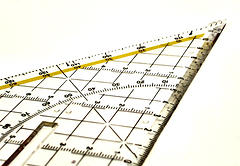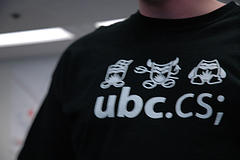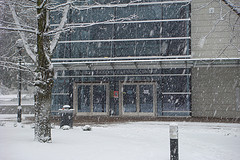helping you to navigate SciEng information
August 18th, 2009 by Eugene Barsky | No Comments »

All IMS articles 2004 and forward are freely available in a postprint format on arXiv <http://arxiv.org/>, as well as those articles posted by authors.
From the IMS website: http://www.imstat.org/publications/arxiv.html
ArXiv is an open access, fully automated electronic archive and distribution server for research articles, now owned and operated by Cornell University, and partially funded by NSF. The main fields it covers are physics, mathematics, non-linear science, computer science, and quantitative biology. Recently, arXiv has cooperated with IMS and the Bernoulli Society to open up a new statistics category within mathematics. We expect this category to eventually grow into a top level archive comparable to e.g. mathematics and physics.
Great news, IMS!
** photo by http://www.flickr.com/photos/saz/
Posted in Main, Mathematics, News, Science - undegraduate classes, Statistics | No Comments »
July 3rd, 2009 by Eugene Barsky | No Comments »

A very recent article on PLoS One is worth the read –
Bollen J, Van de Sompel H, Hagberg A, Chute R, 2009 A Principal Component Analysis of 39 Scientific Impact Measures. PLoS ONE 4(6): e6022. doi:10.1371/journal.pone.0006022
Abstract:
Background
The impact of scientific publications has traditionally been expressed in terms of citation counts. However, scientific activity has moved online over the past decade. To better capture scientific impact in the digital era, a variety of new impact measures has been proposed on the basis of social network analysis and usage log data. Here we investigate how these new measures relate to each other, and how accurately and completely they express scientific impact.
Methodology
We performed a principal component analysis of the rankings produced by 39 existing and proposed measures of scholarly impact that were calculated on the basis of both citation and usage log data.
Conclusions
Our results indicate that the notion of scientific impact is a multi-dimensional construct that can not be adequately measured by any single indicator, although some measures are more suitable than others. The commonly used citation Impact Factor is not positioned at the core of this construct, but at its periphery, and should thus be used with caution.
Frankly, I was surprised by the authors’ conclusion, particularly with this piece: “Our results indicate that the JIF and SJR express a rather particular aspect of scientific impact that may not be at the core of the notion of scientific “impact”. Usage-based measures such as Usage Closeness centrality may in fact be better “consensus” measures.”
I am used to be inquired about Journal Impact Factor (JIF) so often in academia and know that it used for tenure consideration in many departments in UBC.
** photo by testone 22
Posted in Astronomy, Atmospheric Science, Chemical and Biological Engineering, Chemistry, Civil Engineering, Earth and Ocean Sciences, General Science, Geography, Main, Materials Engineering, Mathematics, Mechanical Engineering, Physics, Podcasts, Science - undegraduate classes, Statistics, Wood Sciences | No Comments »
June 9th, 2009 by Eugene Barsky | No Comments »

Thomson Reuters has released its latest figures for Canadian Science last week – http://sciencewatch.com/dr/sci/09/may31-09_2/
Between 2004 and 2008, Thomson Reuters indexed 226,232 papers that listed at least one author address in Canada. Of those papers, the highest percentage appeared in journals classified under the heading of environment/ecology, followed by psychiatry/psychology and geosciences. As the right-hand column shows, the citations-per-paper average for environment/ecology papers from Canada-based authors was 24% above the world average in the field (5.49 cites per paper for Canada versus 4.43 cites for the world). In fact, in all the fields shown here, the impact of Canadian research exceeded the world average, with particularly strong performance in space science (44% above the world average), physics (43% above), and agricultural sciences (+29%).
It is great to see that we are producing a decent share of world’s research. But it seems that Engineering is one of weak points!
** Photo by tripleman
Posted in Astronomy, Atmospheric Science, Chemical and Biological Engineering, Chemistry, Civil Engineering, Earth and Ocean Sciences, General Science, Geography, Main, Materials Engineering, Mathematics, Mechanical Engineering, News, Physics, Science - undegraduate classes, Statistics, Wood Sciences | No Comments »
May 8th, 2009 by Kevin Lindstrom | No Comments »
Statistics isn’t just about bayesian disease mapping and analyzing incomplete multivariate data. Statistics has some very important applications for analyzing hockey – yes, ice hockey. While my team hasn’t made the playoffs for a while except for that glorious 2006 run, it might be interesting to for any of you hockey statisticians to apply the research to the teams currently playing in the NHL playoffs.
Here’s a sample of some the articles available in MathSciNet and Current Index to Statistics dealing with ice hockey.
Thomas, Andrew C. (2007) “Inter-arrival Times of Goals in Ice Hockey,” Journal of Quantitative Analysis in Sports: Volume 3: Issue 3, Article 5. Available at: http://www.bepress.com/jqas/vol3/iss3/5
Thomas, Andrew C. (2006) “The Impact of Puck Possession and Location on Ice Hockey Strategy,” Journal of Quantitative Analysis in Sports: Volume 2: Issue 1, Article 6. Available at: http://www.bepress.com/jqas/vol2/iss1/6
Anthology of Statistics in Sports. Edited by Jim Albert, Jay Bennett and James J. Cochran. ASA-SIAM Series on Statistics and Applied Probability, 16. 2005.
Gill, Paramjit S. (2000) “Late-Game Reversals in Professional Basketball, Football, and Hockey” The American Statistician, Volume 54, Number 2 (May, 2000), pp. 94-99 http://www.jstor.org/stable/2686024
The Journal of Quantitative Analysis in Sports is a great place to browse.
Submitted by Kevin Lindstrom UBC Science and Engineering Librarian
Posted in Amusing stuff, Atmospheric Science, Chemical and Biological Engineering, Chemistry, Civil Engineering, Earth and Ocean Sciences, General Science, Geography, Main, Materials Engineering, Mathematics, Mechanical Engineering, News, Physics, Podcasts, Science - undegraduate classes, Statistics, Uncategorized, Wood Sciences | No Comments »
April 24th, 2009 by Kevin Lindstrom | No Comments »
Canada Excellence Research Chairs – Phase 1 Competition Results
Overview
In 2008, the Government of Canada created a new permanent program to establish 20 prestigious research chairs–Canada Excellence Research Chairs (CERC)–in universities across the country. The CERC program invests $28 million a year to attract and retain the world’s most accomplished and promising minds and help Canada build a critical mass of expertise in the priority research areas of environmental sciences and technologies, natural resources and energy, health and related life sciences and technologies, and information and communication technologies.
Phase 1 Competition Results
The following 17 universities have been invited to compete in Phase 2.
Universities invited to Phase 2 competition
(Number of successful proposals arranged from West to East)
* University of British Columbia (4)
* University of Alberta (5)
* University of Calgary (1)
* University of Saskatchewan (1)
* University of Manitoba (1)
* University of Toronto (5)
* University of Waterloo (4)
* McMaster University (2)
* Queen’s University (1)
* University of Western Ontario (2)
* University of Ottawa (2)
* McGill University (4)
* Université Laval (3)
* Université de Sherbrooke (1)
* Université du Québec à Trois-Rivières (1)
* University of Prince Edward Island (1)
* Dalhousie University (2)
Click here for a list of the successful proposals
Submitted by Kevin Lindstrom Liaison Librarian
Posted in About this blog, Amusing stuff, Atmospheric Science, Chemical and Biological Engineering, Chemistry, Civil Engineering, Earth and Ocean Sciences, General Science, Geography, Main, Materials Engineering, Mathematics, Mechanical Engineering, News, Physics, Podcasts, Science - undegraduate classes, Statistics, Teaching, Uncategorized, Wood Sciences | No Comments »
March 13th, 2009 by Kevin Lindstrom | No Comments »
Imagine no facebook, twitter, myspace, email, internet for a entire day?
Shutdown Day is a Global Internet Experiment whose purpose is to get people to think about how their lives have changed with the increasing use of the home computer, and whether or not any good things are being lost because of this.
The idea of Shutdown Day project is simple – just shutdown your computer for one whole day of the year and involve yourself in some other activities: outdoors, nature, sports, fun stuff with friends and family – whatever, just to remind yourself that there still exists a world outside your monitor screen.
For more information, go to Shutdown Day
Submitted by Kevin Lindstrom Science and Engineering Liaison Librarian
Posted in Atmospheric Science, Chemical and Biological Engineering, Chemistry, Civil Engineering, Earth and Ocean Sciences, General Science, Geography, Main, Materials Engineering, Mathematics, Mechanical Engineering, News, Podcasts, Science - undegraduate classes, Statistics, Teaching, Uncategorized, Wood Sciences | No Comments »
February 25th, 2009 by Eugene Barsky | No Comments »

The most recent Sci-Bites newsletter from Thomson Reuters reports that UBC CS department has the Highest Impact in Computer Science in Canada, ranked by average citations per paper, among Canadian universities that published at least 50 papers in Thomson Reuters-indexed journals of computer science & engineering between 2003 and 2007.
http://sciencewatch.com/dr/sci/09/feb22-09_2/
Congrats to our CS faculty and students!
** Photo by gillicious
Posted in General Science, Main, News, Science - undegraduate classes, Statistics, Uncategorized | No Comments »
February 6th, 2009 by Kevin Lindstrom | No Comments »
The University of British Columbia Library and Springer are delighted to introduce a new Print on Demand feature linked to the Library’s eBook collection: MyCopy powered by SpringerLink.
As a current faculty member of the University of British Columbia, MyCopy allows you to order your own personal print copy of a Springer eBook included in the Library’s collection. The individual copy will be delivered as a printed soft cover version directly to your doorstep. Best of all, it will be available to all patrons for just $24.95 (USD plus GST & PST, including shipping and handling costs).
The University of British Columbia Library is one of the first libraries to introduce the MyCopy service that includes more than 11,000 eBooks out of a total of 30,000 eBooks available on SpringerLink. We invite you to take a look, browse this comprehensive eBook collection and take advantage of the MyCopy service.
If you find an eBook that you would like to use for a course, you can simply copy the URL in the address bar on SpringerLink and add this to your course syllabus. The students can then follow the URL and purchase the eBook directly on http://www.springerlink.com for home delivery.
Below are directions for ordering a MyCopy book for just $24.95 (USD plus GST & PST, including shipping and handling costs)
1. Go to SpringerLink: http://www.springerlink.com
2. Search or browse eBooks in your research area (Available titles will have an orange MyCopy label associated with it.)
3. Click on the eBook or eBook chapter of your interest
4. Click on the MyCopy Logo found underneath the eBook or eBook chapter information, or the “add to shopping cart now” link within the orange box on the right hand column to start the ordering process.
We trust you will find this feature a valuable addition to Springer’s eBook collection. If you have questions, comments, or suggestions, please do not hesitate to contact UBC Librarians Joy Kirchner (joy.kirchner@ubc.ca) and Aleteia Greenwood (aleteia.greenwood@ubc.ca) or Springer at http://www.springerlink.com/feedback.
For a complete list of all Springer Ebooks including MyCopy titles go to the Springer eBooks by Subject Collection page and download the Excel spreadsheet for your discipline. Look for the column that contains the Springerlink openurl and paste this url into your browser.
Submitted by Kevin Lindstrom Liaison Librarian for the Physical and Applied Sciences.
Posted in Atmospheric Science, Chemical and Biological Engineering, Chemistry, Civil Engineering, Earth and Ocean Sciences, General Science, Geography, Main, Materials Engineering, Mathematics, Mechanical Engineering, News, Physics, Science - undegraduate classes, Statistics, Wood Sciences | No Comments »
February 4th, 2009 by Eugene Barsky | No Comments »

This is a quick post to remind you about various standards we have in the SciEng library:
* ASTM up to 2006
* CSA and ANSI standards up to 1995 (How to get those?)
* IEEE Standards: The IEEE Electronic Library provides access to over 1,000 current, revised and superceded standards in the field of electrical and computer engineering. You must be a UBC faculty, student or staff to access these resources. Print standards can be found in the UBC Library catalogue, though coverage varies.
* ISO: We own a number of ISO standards that are listed individually in our library catalogue, mostly from the early 1990s. Try typing ISO and standard? in catalogue search box.
* Open Access Standards (Free):
a.International Telecommunications Union (ITU-T)
b. International Organization for Standardization (ISO) and International Electrotechnical Commission (IEC) Standards. The Standards Council of Canada will grant a license for use of ISO and IEC international standards by recognized Canadian educational institutions in a credit course. Please contact us to learn more about this option.
Please do not hesitate to contact Kevin Lindstrom or Eugene Barsky if you require any additional info!
** Photo by Sifter
Posted in Atmospheric Science, Chemical and Biological Engineering, Chemistry, Civil Engineering, Earth and Ocean Sciences, General Science, Geography, Main, Materials Engineering, Mathematics, Mechanical Engineering, Physics, Science - undegraduate classes, Statistics, Wood Sciences | No Comments »
December 24th, 2008 by Eugene Barsky | No Comments »

We would like to wish you happy holidays! We are looking forward to work with many of you next year!
Enjoy the snow 🙂
** Photo by velkr0
Posted in Atmospheric Science, Chemical and Biological Engineering, Chemistry, Civil Engineering, Earth and Ocean Sciences, General Science, Geography, Main, Materials Engineering, Mathematics, Mechanical Engineering, News, Physics, Science - undegraduate classes, Statistics, Wood Sciences | No Comments »
« Newer Posts - Older Posts »






